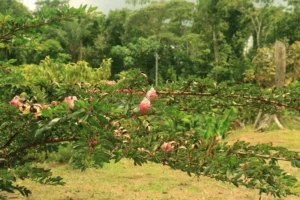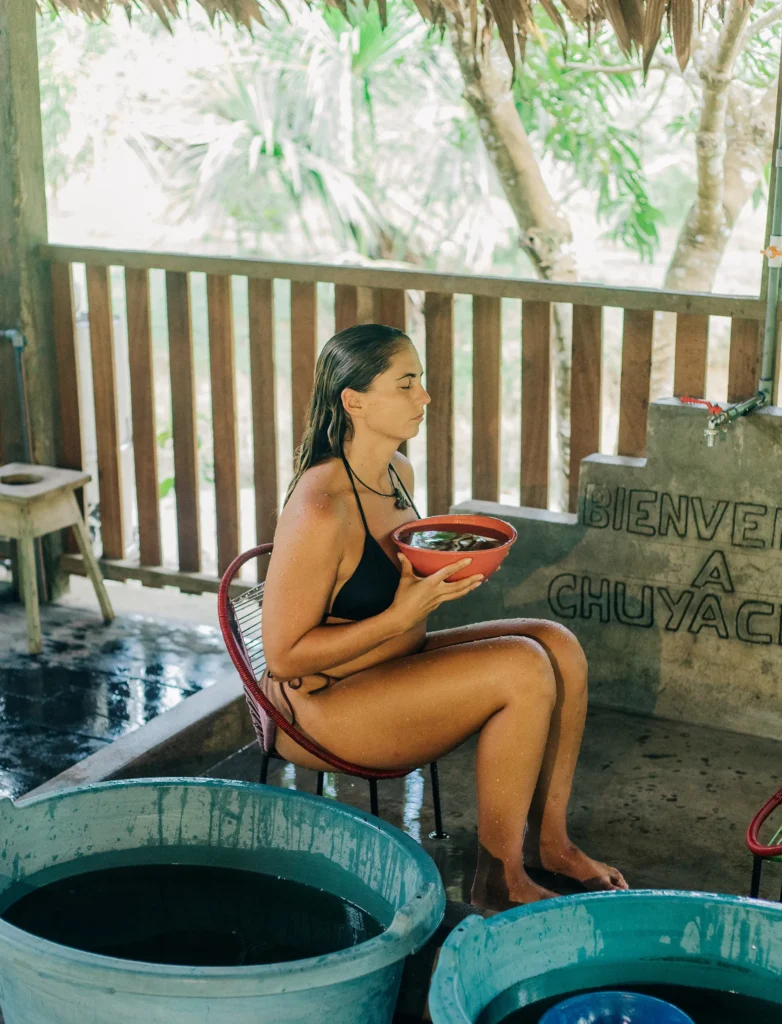


Founder
The Shipibo-Konibo people of the Peruvian Amazon have long practiced ritual plant baths to cleanse the aura and attract positive energies. One special type is the “Baño de Amor” or Love Bath, a kind of baño de florecimiento(“flourishing bath”) aimed at attracting love, unity, and good fortune into one’s lifes. Unlike ordinary medicinal baths for physical ailments, these love baths use “noi rao” – non-medicinal magic plants – to enhance one’s personal attraction, strengthen relationships, and invite luck in romance and friendship. In Shipibo tradition, plants are seen as living spirits, and by bathing in their essence one seeks to “flourish” with love and positive energy. This article explores the storytelling of Don Miguel – a Shipibo healer – and his preparation of the Love Bath using five sacred plants, as well as instructions on how this ritual is performed.


Shipibo love baths fall under a broader category of spiritual baths known as baños de florecimiento. These rituals are performed after initial cleansing baths and are intended to attract good luck, love, friendship, and prosperity. Rather than curing illness, a love bath’s purpose is to “cure” one’s spiritual and social life, to make the bather irresistibly attractive to others and draw in positive relationships. In Shipibo cosmology, the plants used are called noi rao, meaning “remedies for no illness”, which work by developing the necessary seductive and harmonious energy in all kinds of relationships (romantic, friendly, or even business). By using these plant remedies, the user increases their good fortune, for example, being well-liked, receiving gifts, attracting romantic interest, or gaining loyal customers are all seen as signs of “flourishing” in luck.
Crucially, Shipibo wisdom holds that noi rao help with both inner and outer attraction. First, they help one become more appealing and likable (projecting positive energy outward); second, they draw others toward the user (magnetizing good influences inward). Many of these plant formulas were traditionally kept secret by Amazonian healers, but they share common steps: the bather must prepare mentally with clear intention, often fasting and abstaining from strong flavors or activities, to maximize the plants’ effect. As we will see, the ritual involves careful timing with the sun, prayerful respect for plant spirits, and repetitive bathing over a series of days to gradually transform the bather’s energy.
The Shipibo Love Bath that Don Miguel prepares includes a blend of five plant allies, each carrying a symbolic quality for love and well-being. These plants : locally known as Escorpión, Loro, Lengua de Perro, Corazoncito, and Golondrina, are believed to work in harmony to open the heart, sweeten one’s aura, and attract the desired affection or unity. Below we explore each plant’s meaning and any scientific context:
Escorpión is named for its distinctive tail-like flower spike that curls like a scorpion’s tail. The plant’s scientific identity is likely Heliotropium angiospermum, commonly called scorpion’s-tail for its coiled inflorescence of tiny white flowers. In Shipibo lore, Escorpión’s “sting” is aimed at conquering the heart of one’s beloved, it imbues the bath with the power to attract and captivate a desired person. Don Miguel explains that just as a scorpion’s tail delivers a potent sting, this plant delivers a potent charm to “sting” the corazón (heart) of the one you love. Escorpión is thus used to ignite passion and magnetism, helping the bather to “conquistar a tu ser amado”(conquer your loved one’s heart). Even outside folklore, Heliotropium species are known in folk medicine (for example, cola de alacrán in Mexico) for various uses, but in the Love Bath its purpose is purely magical and romantic.
Loro, meaning “parrot” in Spanish, refers to a plant that symbolizes the qualities of green parrots, which are famously devoted pairs. (In some sources, “loro” is a name given to the Canary Island laurel tree Laurus novocanariensis, though that is geographically distant; in the Amazon, “Loro” likely denotes a local plant associated with parrots.) Shipibos say that parrots are always together and never separate, so the Loro plant brings that same unbreakable unity in relationships and families. When included in the baño de amor, Loro’s energy is believed to heal rifts and foster loyalty between lovers or among family members. It “trae unidad a las relaciones y a las familias,” as Don Miguel describes by bringing unity to relationships and family. Botanically, the exact species of this plant in Shipibo practice is uncertain, but its role is clear: Loro blesses the bath with harmony, fidelity, and familial love. One can think of Loro as the ingredient that strengthens bonding, ensuring that love not only sparks (as with Escorpión) but also endures in a stable, loving partnership.
The intriguingly named Lengua de Perro (“dog’s tongue”) is a plant valued for its pleasant aroma and all-around blessing power. In the love bath formula, Lengua de Perro is said to attract abundance, friendship, success in work, and general good luck in addition to love. Its presence ensures the bather not only finds romance but also flourishes in life, with supportive friends, steady employment, and positive energy. This plant is literally called “dog’s tongue” because, in some traditions, the leaves or shape might resemble a tongue, or because dogs (man’s loyal friends) symbolize friendship and fidelity. The exact species used by Don Miguel is identified in Shipibo as a climbing plant called ochiti jana, which was noted by anthropologists as “lengua de perro” (unidentified vine) used in love remedies. Interestingly, one Western species with the same Spanish name is Cynoglossum officinale (a Mediterranean herb), but the Amazonian variety is likely different. What matters in the ritual context is the effect: Lengua de Perro’s fragrant essence “sweetens” the bath, inviting prosperity and loyal connections. Shipibo women use this plant in both baths and perfumes to attract luck. For instance, one woman mixed a dog’s-tongue vine into a perfume and found that her sales in themarket improved consistently. Thus, in the Love Bath, Lengua de Perro ensures love comes with prosperity and loyal friendship, covering all aspects of a flourishing life.
The name Corazoncito means “little heart,” and indeed this plant is known for its heart-shaped leaves. The plant is scientifically identified as Peperomia pellucida, also called “corazón de hombre” (man’s heart) for its tiny shiny heart-like leaves. In Shipibo love baths, Corazoncito brings the energy of love itself: especially self-love and general love. Don Miguel includes Corazoncito to help the bather open their own heart (corazón) to both give and receive love.
It’s about cultivating self-love and inner healing as a foundation, so that one can attract healthy love from others. The presence of those little heart leaves is a visual and spiritual reminder that love starts within. The plant is also mildly aromatic when crushed (giving off a spice-like
scent, and is used medicinally in tropical folk medicine for its soothing properties. In the ritual context, these heart-shaped plants infuse the bath water with vibrations of affection, emotional warmth, and self-worth. Corazoncito is essentially the heart medicine of the formula, believed to help heal past heartaches and encourage the bather to love themselves and thereby attract love in return.
Corazoncito (Peperomia pellucida) growing in the wild. The succulent green leaves are shaped like tiny hearts, symbolizing the plant’s role in fostering self-love and affection in the Shipibo Love Bath. Corazoncito’s heart-shaped leaves (known as “corazón de hombre”) make it a natural emblem of love. By including it, the bath nurtures one’s own heart, promoting both love for oneself and love from others.
Named after a graceful bird (golondrina means “swallow,” a migratory bird often associated with beauty and hope), the Golondrina plant brings the energy of beauty, grace, and attractiveness. Don Miguel refers to it as akin to a “beautiful bird, the dove,” that makes us more attractive physically and energetically. In Amazonian folklore, birds like swallows or doves are symbols of beauty, freedom, and the arrival of good news (or good luck) – think of the phrase “cuando las golondrinas llegan” marking spring and renewal. By using the Golondrina plant in the bath, the idea is to let the bather’s aura shine with radiance and charm, much like the iridescent plumage of a swallow in flight. This plant is believed to “make us pretty” but not only in the aesthetic sense but also in terms of charisma and positive energy that others find attractive.
Scientifically, “hierba de la golondrina” refers to some spurges; one candidate is Euphorbia hypericifolia (a euphorbia with tiny white flowers), or the related Euphorbia thymifolia – these are small herbs with delicate white blossoms, sometimes used in traditional medicine. While those species are known for medicinal uses (like treating inflammation or eye issues, in the Shipibo Love Bath the focus is spiritual: Golondrina carries the blessing of beauty and allure.It complements the other plants by adding that final touch, it’s like a spiritual “cosmetic”, so that when the ritual is done, the person not only feels love and luck but looks and feels radiant, drawing others in as a pretty flower draws hummingbirds. Golondrina’s effect is often described as elevating one’s physical attractiveness and aura, helping the individual glow from within.
Don Miguel, an experienced Shipibo healer (curandero), approaches the preparation of the Love Bath as both an art and a sacred ceremony. It involves careful harvesting of the plants, respectful prayer, and a 10-day bathing regimen aligned with the movements of the sun. Below are the key steps and instructions, combining traditional practices with Don Miguel’s personal ritual:
The first step is to collect the leaves and parts of the five plants (Escorpión, Loro, Lengua de Perro, Corazoncito, Golondrina). Don Miguel does this at dawn, in keeping with tradition that the plants are most potent when gathered at first light. Early morning harvest also ensures privacy: he goes “al abrigo de miradas” (out of others’ sight) to maintain the spiritual purity of the process. Importantly, before cutting or picking any plant, Don Miguel asks the plant spirits for permission. This is done by praying, blowing tobacco smoke (mapacho) over the plant, and sometimes singing an ícaro (a sacred song) to honor the plant. The idea is to show respect and invoke the plant’s cooperation. In Shipibo culture, one should “pedir permiso con respeto para sacar un poco [de la planta]” ask permission respectfully to take some, and also offer something in return or express gratitude. Don Miguel may blow tobacco smoke onto the leaves and say a blessing, acknowledging the plant as a teacher and ally. By doing so, he ensures that the plant’s spirit is willing to help bring love to the person who will bathe. Once permission is felt, he gently collects the needed leaves, avoiding taking too much so the plant continues to thrive. He also keeps intention in mind while harvesting focusing on the purpose (attracting love and unity) so that this intention imbues the plants from the start.
After gathering, Don Miguel carefully washes the leaves with clean water to remove any physical dirt, all the while maintaining a prayerful mindset. He remains in a state of ayuno (fasting) during and after the harvest, as is customary, abstaining from food and strong flavors to keep his energy pure while working with the plants. By late morning, he has a basket of fresh, vibrant leaves ready for the next step.
With the collected leaves of Escorpión, Loro, Lengua de Perro, Corazoncito, and Golondrina, Don Miguel proceeds to create the herbal infusion for the bath. He uses a mortar (or sometimes just his hands and a wooden bowl) to grind all the leaves together into a green paste. As he crushes them, the plants release their juices and aromas, combining their powers. This step is done with patience and prayer often he will hum or sing an icaro specific to florecimiento, to “activate” the plants’ essences. Once the leaves are thoroughly macerated into a pulp, Don Miguel places this paste into a large container (often a bucket or a clay pot) filled with freshwater. He mixes the paste well into the water, stirring clockwise and counter-clockwise, symbolically blending the energies. The water soon turns a deep green, infused with the scent and spirit of the plants.
Traditionally, the plant material is left to macerate (soak) in the water for several hours, sometimes from sunrise until late afternoon. This prolonged soaking allows all the beneficial properties to leach into the water, creating a potent “tea” or infusion. Don Miguel follows this practice: after mixing, he covers the container and lets it sit. In some lineages, the mixture is prepared at dawn and the bath is taken at dusk, meaning the plants steep all day. Don Miguel, however, plans to use the bath both in morning and evening, so he might prepare two batches or simply prepare once and use the same infusion throughout the day. Either way, the concept is to give the plants time to release their “spirit” into the water.
During the maceration period, it’s common to pray or blow more mapacho smoke into the water as an offering. Don Miguel might gently blow tobacco smoke over the container and whisper intentions: for instance, “May this bath bring [Name] the sweet love they seek, may it remove loneliness, may it attract the partner who is truly meant for them,” etc. He keeps the container in a safe, revered spot, treating it as you would a sacred medicine brewing.
By the time the infusion is ready, the water is green and fragrant with a mixture of earthy, sweet, and floral notes – the combined perfume of all five plants. This concoction is now what will be used for the bathing ritual. (Tip: If you are attempting a modern version of this ritual at home with similar plants, you could blend the leaves in a blender with water to make a “smoothie,” then let it sit for a few hours. Just ensure all ingredients are non-toxic and acquired respectfully.)
The core of the Love Bath ritual is bathing in the infused water twice a day for 10 consecutive days. Don Miguel emphasizes consistency and the alignment with natural cycles. Each morning at sunrise and each evening at sunset, he performs the bath ceremony for the person (or instructs them on how to do it themselves under his guidance). The process is as follows:
Don Miguel insists that one should not skip a session; it must be consecutive days to build momentum. The timing is also deliberate: by doing it at these solar turning points (sunrise/sunset), the bather is continuously aligning with natural rhythms, believed to amplify the spell’s potency. Throughout the 10-day period, certain guidelines are observed to maintain the bath’seffectiveness. These are akin to a mini “dieta” (spiritual diet) that one follows whenever doing intensive plant work:
foods or substances can “densify” your energy, whereas the goal is to keep a light, attractive aura.)
After each bath, Don Miguel often has the person sit quietly and pray or meditate for a few minutes. They give thanks to the plants and visualize their heart’s wish (be it a happy relationship, reconciliation, or personal healing). By the tenth day, this repetitive ritual has layered the person in the energy of the plants and the intention of love.
On the final (10th) day’s evening bath, Don Miguel performs a simple closing ceremony. He might use a smudge of incense or palo santo wood, circling it around the bather to seal in the “suerte” (luck) that has been cultivated. He offers final prayers to the plant spirits, thanking Escorpión, Loro, Lengua de Perro, Corazoncito, and Golondrina for their help. If any plant leaves or sediment remain in the container, he usually returns these to the earth often at the base of the trees as a way to give back to nature. In some cases, he will instruct the person to dispose of the used plant bath water at a crossroads or under a flowering tree, symbolically “sowing” their intentions into the Earth so they can bloom.
Don Miguel then advises the person to be alert to opportunities and synchronicities. After the love bath ritual, one might suddenly meet new people or notice a positive shift in how others interact with them. It’s important to act on these opportunities (for example, say yes to social invitations, smile back at that stranger, etc.), as they could be the avenues through which the plants are bringing the desired love.
He also reminds the person that while the bath sets the stage, their own actions and mindset should continue to align with love and unity. In other words, be kind, be open-hearted, communicate your feelings these behaviors will reinforce the bath’s magic. The plants open the road (abre camino), but one must walk through it.
In the long term, some people choose to repeat a love bath periodically (perhaps once a month or around special occasions like the New Year or a full moon) to keep their love energy fresh.
However, Don Miguel warns not to overdo it or become overly fixated, respect the plants and use them purposefully, then allow the results to unfold naturally.If the intention was to reconcile with a specific person or to soften a hardened heart, one might see results quickly (a phone call from a parent, a more affectionate spouse, etc.). If the intention was to attract a new soulmate, it could take a little time for the universe to arrange the meeting – patience and faith are key. Meanwhile, the person often reports feeling different in themselves: more confident, more loving, more “attractive” in the sense of energy. This inner change is perhaps the real magic.
The Shipibo Love Bath is a beautiful example of Amazonian plant spirit medicine interwoven with ritual, intention, and symbolic storytelling. In a modern context, one can appreciate how holistic this practice is, it addresses mind (intention, visualization), body (the sensory experience of the bath), and spirit (the invocation of plant allies and cosmic directions). It’s both storytelling and education: as Don Miguel prepares the bath, he often shares the stories of each plant (how Escorpión got its name, or how parrots mate for life inspiring Loro’s power).
This narrative aspect helps the participant truly engage with the process, not just physically but with their imagination and belief.
While some might view such rituals as “magic” or superstition, there is growing understanding even in scientific circles that belief and intention can influence psychological outcomes. The Love Bath provides a focused way to practice self-love and openness, which inevitably affects how one carries themselves and thus how others respond. The aromatic herbs and the act of self- care in bathing can reduce stress, improve one’s mood and confidence all factors that make a person more attractive socially. In essence, the ritual can work on both a mystical level and a practical psychosomatic level.
For those interested in trying a version of this ritual, it’s worth noting a few adaptations: If you don’t have access to the Amazonian plants, you might substitute analogous herbs (for example, you could use rose petals or jasmine for love, basil or mint for prosperity, and bay laurel for unity as these are found in other love/abundance spells). What’s crucial is maintaining the spirit of the practice: approach your chosen plants with respect, set a clear intention (write it down or speak it aloud), bathe with mindfulness (perhaps at sunrise/sunset), and do it for a dedicated number of days. Always ensure any plant you use is safe for skin contact and has no harmful effects.
As taught by the Shipibo, remember to balance cleansing and flourishing. Sometimes a cleansing bath is done before a love bath to remove negativity (as mentioned, some baths are to remove “saladera” – bad luck “salt” – after which a florecimiento bath adds good luck). So if you feel weighed down by past hurt, you might do a simple herbal cleansing (with, say, rue or eucalyptus) before embarking on the Love Bath series. After the ritual, live in a way that maintains the positive energy like kindness, gratitude, and integrity keep one’s aura bright, whereas jealousy, anger or deceit can “dirty” it again.
In Shipibo belief, humans and nature are deeply intertwined. The Love Bath of Don Miguel exemplifies this: five humble plants become a bridge between a person’s prayer for love and the fulfillment of that prayer. By bathing in the gifts of the Earth, one is both cleansing andadorning themselves in the metaphorical “floral fragrance” of love and luck. It’s a tradition that carries both poetic symbolism (dog’s tongue to speak friendship, little heart to grow love) and practical guidance (take time for self-care, align with natural cycles, be intentional in love).
In conclusion, the Shipibo baños de amor remind us that love is a garden that can be cultivated with the right herbs, the right intentions, and a little ritual magic, we can nurture the conditions for love to bloom in our lives. Whether one believes in the literal spirit of the plants or not, the act of engaging with nature and ritual can open one’s heart in profound ways. And as the Shipibo say, “jakon rate” may you be well, may love find you, and like the parrots in the trees, may you find a companion to share your song with, never to be alone.
Sources: Traditional knowledge as recounted by Don Miguel; ethnographic research on Shipibo noi rao (seductive plant remedies); anthropological descriptions of plant bath preparation and use; and botanical references for plant identification.